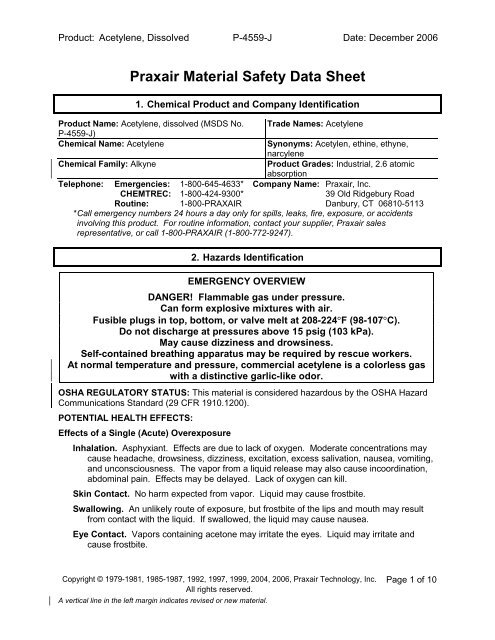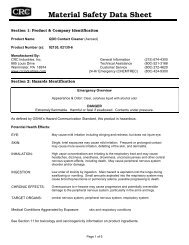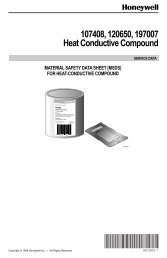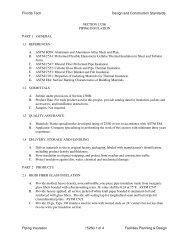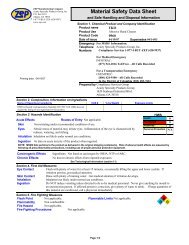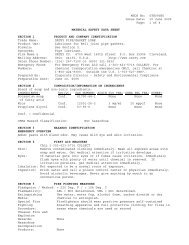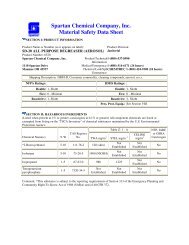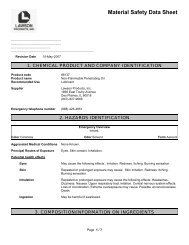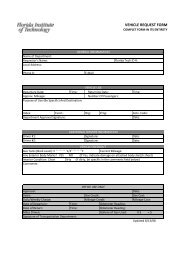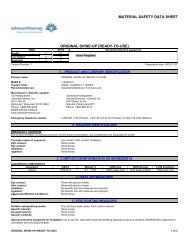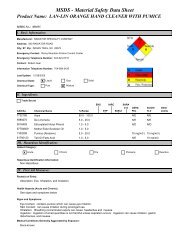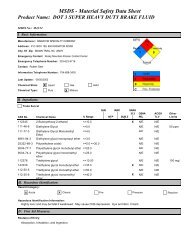Praxair Material Safety Data Sheet - GE Industrial Systems
Praxair Material Safety Data Sheet - GE Industrial Systems
Praxair Material Safety Data Sheet - GE Industrial Systems
Create successful ePaper yourself
Turn your PDF publications into a flip-book with our unique Google optimized e-Paper software.
Product: Acetylene, Dissolved P-4559-J Date: December 2006PROTECTION OF FIREFIGHTERS: DAN<strong>GE</strong>R! Flammable gas under pressure. Evacuate allpersonnel from danger area. Immediately cool cylinders with water spray from maximumdistance, taking care not to extinguish flames. If flames are accidentally extinguished, explosivere-ignition may occur. Use self-contained breathing apparatus. Remove ignition sources ifwithout risk. Stop flow of gas if without risk while continuing cooling water spray. Remove allcylinders from area of fire if without risk. Allow fire to burn out. On-site fire brigades mustcomply with OSHA 29 CFR 1910.156.Specific Physical and Chemical Hazards. Heat of fire can build pressure in cylinder andcause it to rupture. Acetylene cylinders are provided with pressure relief devices designed tovent contents when exposed to elevated temperature. No part of a cylinder should be subjectedto a temperature higher than 125°F (52°C). If venting or leaking acetylene catches fire, do notextinguish flames. Flammable vapors may spread from leak, creating an explosive reignitionhazard. Vapors can be ignited by pilot lights, other flames, smoking, sparks, heaters, electricalequipment, static discharge, or other ignition sources at locations distant from product handlingpoint. Explosive atmospheres may linger. Before entering area, especially confined areas,check atmosphere with an approved explosion meter.Protective Equipment and Precautions for Firefighters. Firefighters should wear selfcontainedbreathing apparatus and full fire-fighting turnout gear.6. Accidental Release MeasuresSTEPS TO BE TAKEN IF MATERIAL IS RELEASED OR SPILLED:DAN<strong>GE</strong>R! Flammable gas under pressure.Personal Precautions. Forms explosive mixtures with air. Immediately evacuate all personnelfrom danger area. Use self-contained breathing apparatus where needed. Remove all sourcesof ignition if without risk. Reduce vapors with fog or fine water spray. Shut off flow if withoutrisk. Ventilate area or move leaking cylinder to well-ventilated area. Flammable gas mayspread from leak. Before entering area, especially confined areas, check atmosphere with anappropriate device.Environmental Precautions. Prevent waste from contaminating the surrounding environment.Keep personnel away. Discard any product, residue, disposable container, or liner in anenvironmentally acceptable manner, in full compliance with federal, state, and local regulations.If necessary, call your local supplier for assistance.7. Handling and StoragePRECAUTIONS TO BE TAKEN IN HANDLING: Keep away from heat, sparks, and openflame. Use only spark-proof tools and explosion-proof equipment. Never use acetylene atpressures exceeding 15 psig (103.5 kPa). Can cause rapid suffocation due to oxygendeficiency. Close valve after each use; keep closed even when empty. Arcs and sparks canignite combustible materials. Prevent fires. For more information on fire prevention inwelding and cutting, see NFPA 51B, Standard for Fire Prevention During Welding, Cutting, andOther Hotwork, published by the National Fire Protection Association, 1 Batterymarch Park, POBox 9101, Quincy, MA 02269-9101; 1-800-344-3555; www.nfpa.org. Do not strike an arc on acompressed gas cylinder. The defect produced by an arc burn could lead to cylinder rupture.PRECAUTIONS TO BE TAKEN IN STORA<strong>GE</strong>: Acetylene storage in excess of 2,500 cu ft(70.79 m 3 ) is prohibited in buildings with other occupancies. Store and use with adequateventilation. Separate acetylene cylinders from oxygen and other oxidizers by at least 20 ftPage 3 of 10
Product: Acetylene, Dissolved P-4559-J Date: December 2006(6.1 m), or use a barricade of noncombustible material. This barricade should be at least 5 ft(1.53 m) high and have a fire resistance rating of at least ½ hour. Post “No Smoking or OpenFlames” signs in storage and use areas. There must be no sources of ignition. All electricalequipment in storage areas must be explosion-proof. Storage areas must meet national electriccodes for Class 1 hazardous areas. Store only where temperature will not exceed 125°F(52°C). For other precautions in using acetylene, see section 16.RECOMMENDED PUBLICATIONS: For further information on storage, handling, and use, see<strong>Praxair</strong> publication P-14-153, Guidelines for Handling Gas Cylinders and Containers. Obtainfrom your local supplier.8. Exposure Controls/Personal ProtectionSee section 16 for important information on by-products generated during usein welding and cutting.COMPONENT OSHA PEL ACGIH TLV-TWA (2006)Acetylene N.E.* Simple asphyxiant*N.E.–Not Established.NOTE: Acetone, used as a solvent, has a TLV-TWA of 500 ppm for acetone and a TLV-STELof 750 ppm (ACGIH, 2006). OSHA PEL, 1000 ppm, 2400 mg/m 3 .TLV-TWAs should be used as a guide in the control of health hazards and not as fine linesbetween safe and dangerous concentrations.IDLH = Not available.ENGINEERING CONTROLS:Local Exhaust. Use a local exhaust system, if necessary, to prevent oxygen deficiency and tokeep hazardous fumes and gases in the worker’s breathing zone below all applicable exposurelimits.Mechanical (General). General exhaust ventilation may be acceptable if it can maintain anadequate supply of air and keep hazardous fumes and gases in the worker’s breathing zonebelow all applicable exposure limits.Special. NoneOther. NonePERSONAL PROTECTIVE EQUIPMENT:Skin Protection. Wear work gloves when handling cylinders; welding gloves for welding andcutting.Eye/Face Protection. Wear goggles with filter lenses selected as per ANSI Z49.1. Provideprotective screens and goggles, if necessary, to protect others. Select as per OSHA 29 CFR1910.33. For welding, see section 16.Respiratory Protection. Use air-purifying or air-supplied respirators, as appropriate, wherelocal or general exhaust ventilation is inadequate. Adequate ventilation must keep workerexposure below all applicable limits for fumes, gases, and other by-products of welding withacetylene. See sections 3, 10, and 16 for details. An air-supplied respirator must be used inconfined spaces. Respiratory protection must conform to OSHA rules as specified in 29 CFR1910.134. Select per OSHA 29 CFR 1910.134 and ANSI Z88.2.Page 4 of 10
Product: Acetylene, Dissolved P-4559-J Date: December 2006Other Protective Equipment. As needed, wear hand, head, and body protection, which helpto prevent injury from radiation and sparks. See ANSI Z49.1. At a minimum, this includeswelder’s gloves and protective goggles, and may include arm protectors, aprons, hats, andshoulder protection, as well as substantial clothing. Regardless of protective equipment, nevertouch live electrical parts.9. Physical and Chemical PropertiesAPPEARANCE:Colorless gasODOR:Acetylene of 100% purity is odorless, butcommercial acetylene has a distinctive,garlic-like odor.ODOR THRESHOLD:Not available.PHYSICAL STATE:Gas at normal temperature and pressurepH:Not applicable.SUBLIMATION POINT at 1 atm:-118°F (-83.3°C)MELTING POINT at 10 psig (170 kPa abs):-116°F (-82.2°C)BOILING POINT at 10 psig (170 kPa abs):-103.4°F (-75.2°C)FLASH POINT:-0°F (-17.8°C)EVAPORATION RATE (Butyl Acetate = 1):Not applicable.FLAMMABILITY:FlammableFLAMMABLE LIMITS IN AIR, % by volume: LOWER: 2.5% UPPER: 100%VAPOR PRESSURE at 70°F (21.1°C):649.6 psia (4479 kPa abs)*VAPOR DENSITY at 32°F (0°C) and 1 atm: 0.07314 lb/ft 3 (1.1716 kg/m 3 )SPECIFIC GRAVITY (H 2 O = 1):Not applicable.SPECIFIC GRAVITY (Air = 1) at 32°F (0°C) and 1 atm: 0.906SOLUBILITY IN WATER vol/vol at 32°F (0°C): 1.7PARTITION COEFFICIENT: n-octanol/water: Not available.AUTOIGNITION TEMPERATURE:581°F (305°C) at 1 atmDECOMPOSITION TEMPERATURE:Not available.PERCENT VOLATILES BY VOLUME: 100MOLECULAR WEIGHT: 26.04MOLECULAR FORMULA: C 2 H 2*Maximum cylinder pressure: 250 psig (kPa) at 70°F (21.1°C)10. Stability and ReactivityCHEMICAL STABILITY: Unstable StableAcetylene is stable as shipped. Avoid use at pressures above 15 psig (103 kPa).CONDITIONS TO AVOID: Elevated temperature and pressure and/or the presence of acatalyst.INCOMPATIBLE MATERIALS: Copper, silver, mercury, or their alloys; oxidizing agents; acids;halogens; moisture.HAZARDOUS DECOMPOSITION PRODUCTS: Thermal decomposition or burning mayproduce CO/CO 2 H 2 . The welding and cutting process may form reaction products such as COand CO 2 . Other decomposition products of normal operation originate from the volatilization,reaction, or oxidation of the material being worked.Page 5 of 10
Product: Acetylene, Dissolved P-4559-J Date: December 2006POSSIBILITY OF HAZARDOUS REACTIONS: May Occur Will Not OccurFire or explosion may result from use at elevated temperatures and pressures or from use withincompatible materials.11. Toxicological InformationACUTE DOSE EFFECTS: No known effects from acetylene gas. The welding process maygenerate hazardous fumes and gases. (See sections 8, 10, 15, and 16.)12. Ecological InformationECOTOXICITY: No adverse ecological effects expected.OTHER ADVERSE EFFECTS: None known. Acetylene does not contain any Class I or Class IIozone-depleting chemicals.13. Disposal ConsiderationsWASTE DISPOSAL METHOD: Do not attempt to dispose of residual or unused quantities.Return cylinder to supplier.DOT/IMO SHIPPING NAME:HAZARD PACKINGCLASS: 2.1 GROUP/Zone:SHIPPING LABEL(s):PLACARD (when required):14. Transport InformationAcetylene, dissolved.IDENTIFICATIONNone NUMBER: UN1001FLAMMABLE GASFLAMMABLE GASPRODUCTRQ:NoneSPECIAL SHIPPING INFORMATION: Cylinders should be transported in a secure position, in awell-ventilated vehicle. Cylinders transported in an enclosed, nonventilated compartment of avehicle can present serious safety hazards.Shipment of compressed gas cylinders that have been filled without the owner’s consent is aviolation of federal law [49 CFR 173.301(b)].MARINE POLLUTANTS: Acetylene is not listed as a marine pollutant by DOT.15. Regulatory InformationThe following selected regulatory requirements may apply to this product. Not all suchrequirements are identified. Users of this product are solely responsible for compliance with allapplicable federal, state, and local regulations.U.S. FEDERAL REGULATIONS:EPA (ENVIRONMENTAL PROTECTION A<strong>GE</strong>NCY)CERCLA: COMPREHENSIVE ENVIRONMENTAL RESPONSE, COMPENSATION,AND LIABILITY ACT OF 1980 (40 CFR Parts 117 and 302):Reportable Quantity (RQ): NonePage 6 of 10
Product: Acetylene, Dissolved P-4559-J Date: December 2006SARA: SUPERFUND AMENDMENT AND REAUTHORIZATION ACT:SECTIONS 302/304: Require emergency planning based on Threshold PlanningQuantity (TPQ) and release reporting based on Reportable Quantities (RQ) ofExtremely Hazardous Substances (EHS) (40 CFR Part 355):TPQ: NoneEHS RQ (40 CFR 355): NoneSECTIONS 311/312: Require submission of MSDSs and reporting of chemicalinventories with identification of EPA hazard categories. The hazard categories forthis product are as follows:IMMEDIATE: NoDELAYED: NoPRESSURE: YesREACTIVITY: YesFIRE: YesSECTION 313: Requires submission of annual reports of release of toxic chemicalsthat appear in 40 CFR Part 372.Acetylene is not subject to reporting under Section 313.40 CFR 68: RISK MANA<strong>GE</strong>MENT PROGRAM FOR CHEMICAL ACCIDENTALRELEASE PREVENTION: Requires development and implementation of riskmanagement programs at facilities that manufacture, use, store, or otherwise handleregulated substances in quantities that exceed specified thresholds.Acetylene is listed as a regulated substance in quantities of 10,000 lb (4536 kg) orgreater.TSCA: TOXIC SUBSTANCES CONTROL ACT: Acetylene is listed on the TSCAinventory.OSHA: OCCUPATIONAL SAFETY AND HEALTH ADMINISTRATION:29 CFR 1910.119: PROCESS SAFETY MANA<strong>GE</strong>MENT OF HIGHLY HAZARDOUSCHEMICALS: Requires facilities to develop a process safety management programbased on Threshold Quantities (TQ) of highly hazardous chemicals.Acetylene is not listed in Appendix A as a highly hazardous chemical. However, anyprocess that involves a flammable gas on site in one location in quantities of 10,000lb (4536 kg) or greater is covered under this regulation unless the gas is used as afuel.STATE REGULATIONS:CALIFORNIA: Acetylene is not listed by California under the SAFE DRINKING WATERAND TOXIC ENFORCEMENT ACT OF 1986 (Proposition 65).PENNSYLVANIA: Acetylene is subject to the PENNSYLVANIA WORKER ANDCOMMUNITY RIGHT-TO-KNOW ACT (35 P.S. Sections 7301-7320).16. Other InformationBe sure to read and understand all labels and instructions supplied with all containers of thisproduct.ADDITIONAL SAFETY AND HEALTH HAZARDS: Using this product in welding and cuttingmay create additional hazards.Read and understand the manufacturer’s instructions and the precautionary labels on theproducts used in welding and cutting. For other safe practices information and a more-detaileddescription of the health hazards of welding and their consequences, ask your welding productsPage 7 of 10
Product: Acetylene, Dissolved P-4559-J Date: December 2006supplier for a copy of <strong>Praxair</strong>’s free safety booklet, P-52-529, Precautions and Safe Practices forElectric Welding and Cutting, and for other manufacturers’ safety publications. For a detailedtreatment, get ANSI Z49.1, <strong>Safety</strong> in Welding, Cutting, and Allied Processes, published by theAmerican Welding Society (AWS), 550 N.W. Le Jeune Rd., Miami, FL 33126, http://www.aws.org/, orsee OSHA’s Web site at http://www.osha-slc.gov/SLTC/weldingcuttingbrazing/. Order AWSdocuments from Global Engineering Documents, 15 Inverness Way East, Englewood, CO80112-5710, http://global.ihs.com/.FUMES AND GASES can be dangerous to your health and may cause serious lungdisease.• Keep your head out of fumes. Do not breathe fumes and gases. Use enoughventilation, local exhaust, or both to keep fumes and gases from your breathingzone and the general area. Short-term overexposure to fumes may causedizziness, nausea, and dryness or irritation of the nose, throat, and eyes or maycause other similar discomfort.Fumes and gases cannot be classified simply. The amount and type depend on the metalbeing worked and the process, procedure, equipment, and supplies used. Possibledangerous materials may be found in fluxes, electrodes, and other materials. Get an MSDSfor every material you use.Contaminants in the air may add to the hazard of fumes and gases. One such contaminant,chlorinated hydrocarbon vapors from cleaning and degreasing activities, poses a specialrisk.To find the quantity and content of fumes and gases, you can take air samples. Byanalyzing these samples, you can find out what respiratory protection you need. Onerecommended sampling method is to take air from inside the worker’s helmet or from theworker’s breathing zone. See AWS F1.1, Methods for Sampling and Analyzing Gases forWelding and Allied Processes, available from the American Welding Society, 550 N.W. LeJeune Rd., Miami, FL 33126.NOTES TO PHYSICIAN:Acute: Gases, fumes, and dusts may cause irritation to the eyes, lungs, nose, andthroat. Some toxic gases associated with welding and related processes may causepulmonary edema, asphyxiation, and death. Acute overexposure may include signs andsymptoms such as watery eyes, nose and throat irritation, headache, dizziness, difficultybreathing, frequent coughing, or chest pains.Chronic: Protracted inhalation of air contaminants may lead to their accumulation in thelungs, a condition that may be seen as dense areas on chest x-rays. The severity ofchange is proportional to the length of exposure. The changes seen are not necessarilyassociated with symptoms or signs of reduced lung function or disease. In addition, thechanges on x-rays may be caused by non-work-related factors such as smoking, etc.PROTECTIVE CLOTHING AND EQUIPMENT FOR WELDING OPERATIONS:PROTECTIVE GLOVES: Wear welding gloves.EYE PROTECTION: Wear a helmet or use a face shield with a filter lens. Select lensper ANSI Z49.1. Provide protective screens and flash goggles if needed to protectothers; select per OSHA 29 CFR 1910.133.OTHER PROTECTIVE EQUIPMENT: Wear hand, head, and body protection. (SeeANSI Z49.1.) Worn as needed, these help prevent injury from radiation, sparks, andelectrical shock. Minimum protection includes welder’s gloves and a face shield. ForPage 8 of 10
Product: Acetylene, Dissolved P-4559-J Date: December 2006added protection, consider arm protectors, aprons, hats, shoulder protection, and dark,substantial clothing.OTHER HAZARDOUS CONDITIONS OF HANDLING, STORA<strong>GE</strong>, AND USE: Flammable gasunder pressure. Use piping and equipment adequately designed to withstand pressures to beencountered. Acetylene systems should be installed only by persons knowledgeable ofthe unique properties of acetylene and trained and experienced in such installation. Allpiped acetylene systems and associated equipment must be grounded. Electrical equipmentmust be non-sparking or explosion-proof. Leak check with soapy water; never use a flame.Use a backflow prevention device in any piping. In choosing tools and equipment, avoidmaterials incompatible with acetylene. Copper, silver, and mercury and their salts,compounds, and high-concentration alloys can form explosive compounds with acetylene.Never use copper piping for acetylene service; use only steel or wrought iron. Brass containingless than 65% copper and certain nickel alloys are generally acceptable for use in acetyleneservice but may not be adequate if high corrosion or excess moisture is present. Never workon a pressurized system. If there is a leak, close the cylinder valve. Blow the system down inan environmentally safe manner in compliance with all federal, state, and local laws; then repairthe leak. Never place a compressed gas cylinder where it may become part of anelectrical circuit.Mixtures. When you mix two or more gases or liquefied gases, you can create additional,unexpected hazards. Obtain and evaluate the safety information for each component beforeyou produce the mixture. Consult an industrial hygienist or other trained person when youevaluate the end product. Remember, gases and liquids have properties that can cause seriousinjury or death.HAZARD RATING SYSTEMS:NFPA RATINGS:HMIS RATINGS:HEALTH = 0 HEALTH = 2FLAMMABILITY = 4 FLAMMABILITY = 4INSTABILITY = 2 PHYSICAL HAZARD = 2SPECIAL = NoneSTANDARD VALVE CONNECTIONS FOR U.S. AND CANADA:THREADED:The CGA-510 connection is standard forcylinders of greater than 50 cu ft (1.42 m 3 )capacity. See CGA Pamphlet V-1 for other,limited-standard connections.PIN-INDEXED YOKE:Not applicable.ULTRA-HIGH-INTEGRITY CONNECTION: Not applicable.Use the proper CGA connections. DO NOT USE ADAPTERS. Additional limited-standardconnections may apply. See CGA pamphlet V-1 listed below.Page 9 of 10
Product: Acetylene, Dissolved P-4559-J Date: December 2006Ask your supplier about free <strong>Praxair</strong> safety literature as referred to in this MSDS and on thelabel for this product. Further information can be found in the following materials published bythe Compressed Gas Association, Inc. (CGA), 4221 Walney Road, 5 th Floor, Chantilly, VA20151-2923, Telephone (703) 788-2700, http://www.cganet.com/Publication.asp.AV-1 Safe Handling and Storage of Compressed GasesG-1.1 Commodity Specification for AcetyleneG-1 AcetyleneP-1 Safe Handling of Compressed Gases in ContainersSB-4 Handling Acetylene Cylinders in Fire SituationsSB-8 Use of Oxy-Fuel Gas Welding and Cutting ApparatusV-1 Compressed Gas Cylinder Valve Inlet and Outlet Connections— Handbook of Compressed Gases, Fourth Edition<strong>Praxair</strong> asks users of this product to study this MSDS and become aware of product hazardsand safety information. To promote safe use of this product, a user should (1) notify employees,agents, and contractors of the information in this MSDS and of any other known producthazards and safety information, (2) furnish this information to each purchaser of the product,and (3) ask each purchaser to notify its employees and customers of the product hazards andsafety information.The opinions expressed herein are those of qualified experts within <strong>Praxair</strong>, Inc. Webelieve that the information contained herein is current as of the date of this <strong>Material</strong><strong>Safety</strong> <strong>Data</strong> <strong>Sheet</strong>. Since the use of this information and the conditions of use of theproduct are not within the control of <strong>Praxair</strong>, Inc., it is the user’s obligation todetermine the conditions of safe use of the product.<strong>Praxair</strong> MSDSs are furnished on sale or delivery by <strong>Praxair</strong> or the independent distributors and supplierswho package and sell our products. To obtain current MSDSs for these products, contact your <strong>Praxair</strong>sales representative or local distributor or supplier, or download from www.praxair.com. If you havequestions regarding <strong>Praxair</strong> MSDSs, would like the form number and date of the latest MSDS, or wouldlike the names of the <strong>Praxair</strong> suppliers in your area, phone or write the <strong>Praxair</strong> Call Center (Phone: 1-800-PRAXAIR; Address: <strong>Praxair</strong> Call Center, <strong>Praxair</strong>, Inc., PO Box 44, Tonawanda, NY 14151-0044).<strong>Praxair</strong> and the Flowing Airstream design are trademarks or registered trademarks of<strong>Praxair</strong> Technology, Inc. in the United States and/or other countries.<strong>Praxair</strong>, Inc.39 Old Ridgebury RoadDanbury, CT 06810-5113Printed in USA Page 10 of 10


